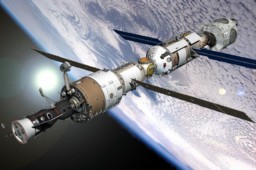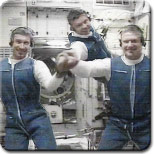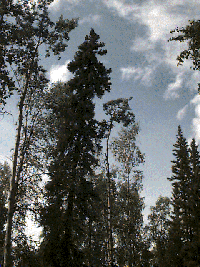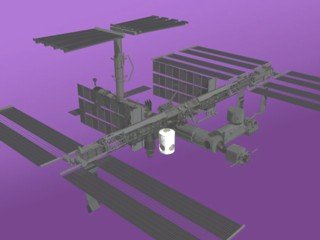|
Life support systems on the ISS provide oxygen,
absorb carbon dioxide, and manage vaporous emissions from the astronauts
themselves. It's all part of breathing easy in our home in space.
by Patrick L.Barry
Many of us stuck on Earth wish we could
join (at least temporarily) the crew aboard the International Space
Station (ISS). Floating effortlessly from module to module, looking
down on Earth from a breathtaking height of 350 kilometres.... It's
a dream come true for innumerable space lovers.
But be careful what you wish for! Living
on the Space Station also means hard work, cramped quarters, and...
what's that smell? Probably more outgassing from a scientific experiment
or, worse yet, a crewmate.
With 3 to 7 people sharing a small
enclosed volume on the still-growing Space Station, air management
is critical.
Life support systems on the ISS must
not only supply oxygen and remove carbon dioxide from the cabin's
atmosphere, but also prevent gases like ammonia and acetone, which
people emit in small quantities, from accumulating. Vaporous chemicals
from science experiments are a potential hazard, too, if they combine
in unforeseen ways with other elements in the air supply.
So, while air in space is undeniably
rare, managing it is no small problem for ISS life support engineers.
Making oxygen from water

NASA An artist's
rendering of the ISS
|
Most people can survive only a couple
of minutes without oxygen, and low concentrations of oxygen can
cause fatigue and blackouts.
To ensure the safety of the crew, the
ISS will have redundant supplies of that essential gas.
"The primary source of oxygen will
be water electrolysis, followed by O2 in a pressurised
storage tank," said Jay Perry, an aerospace engineer at NASA's Marshall
Space Flight Centre working on the Environmental Control
and Life Support Systems (ECLSS) project. ECLSS
engineers at Marshall, at the Johnson Space Centre and elsewhere
are developing, improving and testing primary life support systems
for the ISS.
Most of the station's oxygen will come
from a process called "electrolysis," which uses electricity from
the ISS solar panels to split water into hydrogen gas and oxygen
gas.
Each molecule of water contains two
hydrogen atoms and one oxygen atom. Running a current through water
causes these atoms to separate and recombine as gaseous hydrogen
(H2) and oxygen (O2).
The oxygen that people breathe on Earth
also comes from the splitting of water, but it's not a mechanical
process. Plants, algae, cyanobacteria and phytoplankton all split
water molecules as part of photosynthesis -- the process that converts
sunlight, carbon dioxide and water into sugars for food. The hydrogen
is used for making sugars, and the oxygen is released into the atmosphere.
"Eventually, it would be great if we
could use plants to (produce oxygen) for us," said Monsi Roman,
chief microbiologist for the ECLSS project at MSFC. "The byproduct
of plants doing this for us is food."
However, "the chemical-mechanical systems
are much more compact, less labour intensive, and more reliable
than a plant-based system," Perry noted. "A plant-based life support
system design is presently at the basic research and demonstration
stage of maturity and there are a myriad of challenges that must
be overcome to make it viable."
Hydrogen that's leftover from splitting
water will be vented into space, at least at first. NASA engineers
have left room in the ECLSS hardware racks for a machine that combines
the hydrogen with excess carbon dioxide from the air in a chemical
reaction that produces water and methane. The water would help replace
the water used to make oxygen, and the methane would be vented to
space.
"We're looking to close the loop completely,
where everything will be (re)used," Roman said. Various uses for
the methane are being considered, including expelling it to help
provide the thrust necessary to maintain the Space Station's orbit.
At present, "all of the venting that
goes overboard is designed to be non-propulsive," Perry said.

NASA The ISS's first
crew -- Bill Shepherd, Sergei Krikalev and Yuri Gidzenko --
aboard the Space Station.
|
The ISS will also have large tanks
of compressed oxygen mounted on the outside of the airlock module.
These tanks will be the primary supply of oxygen for the U.S. segment
of the ISS until the main life support systems arrive with Node
3 in 2005. After that, the tanks will serve as a backup
oxygen supply.
For example, while the crew were waiting
for activation of a water electrolysis machine on the Zvezda Service
Module, they breathed oxygen from "perchlorate candles," which produce
O2 via chemical reactions inside a metal canister.
"You've got a metallic
canister with this material (perchlorate) packed inside it," Perry
explained. "They shove this canister into a reactor and then pull
an igniter pin. Once the reaction starts, it continues to burn until
it's all used." Each canister releases enough oxygen for one person
for one day.
"It's really the same
technology that's used in commercial aircraft," he continued. "When
the oxygen mask drops down, they say to yank on it, which actuates
the igniter pin. That's why you have to give it a tug to begin the
flow of oxygen."
Keeping the air "clean"
At present, carbon dioxide is removed
from the air by a machine on the Zvezda Service Module based on
a material called "zeolite," which acts as a molecular sieve, according
to Jim Knox, a carbon dioxide control specialist at MSFC.

NASA The oxygen
that humans and animals breathe on Earth is produced by plants
and other photosynthetic organisms such as algae.
|
The removed CO2 will be
vented to space. Engineers are also thinking of ways to recycle
the gas.
In addition to exhaled CO2,
people also emit small amounts of other gases. Methane and carbon
dioxide are produced in the intestines, and ammonia is created by
the breakdown of urea in sweat. People also emit acetone, methyl
alcohol and carbon monoxide -- which are by-products of metabolism
-- in their urine and their breath.
Activated charcoal filters are the
primary method for removing these chemicals from the air.
Maintaining a healthy atmosphere is
made even more complex by the dozens of chemicals that will be used
in the science experiments on board the ISS.
"In a 30 year period, there could be
any number of different types of experimental facilities on board
that could have any number of chemical reagents," Perry said.
Some of these chemicals are likely
to be hazardous, particularly if they're allowed to combine in unforeseen
ways, Perry said. Keeping these chemicals out of the air will be
vital for the crew's health.
When the Space Station was first being
designed, NASA engineers envisioned a centralised chemical-handling
system that would manage and contain all the chemicals used for
experiments. But such a system proved to be too complex.
"The ability for the Station to provide
generic monitoring capability to try to cover the broad spectrum
of chemicals that 15 plus years of basic research will require --
obviously that's not something that the Station itself can provide,"
Perry said.

NASA An illustration
showing the location of Node 3, where the ECLSS life support
equipment will be housed. Note that the Station components
in the line of sight to Node 3 are transparent in this image.
|
A safety review for each proposed experiment
will determine the level of containment that the rack-mounted experiment
facilities must provide. In the event of a release, the crew will
seal off the contaminated module and then follow procedures for
cleanup, if possible.
But careful planning and well-designed
hardware should minimise the risk of this scenario, enabling the
crew of the Space Station to breathe easy.
|
